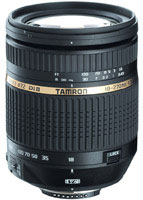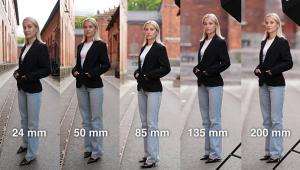Lens Tech Update
![]()
Lens Tech Update
Is This the World's Longest Range Zoom?
by George Schaub
 Not
so far back photographers were leery of zoom lenses that exceeded a 3x focal
length ratio; in other words, say you started at 70mm, then a 210mm outer range
would be considered "safe." (Indeed even further back photographers
considered zooms of any kind less than desirable when compared to fixed focal
length lenses.) The feeling was, and indeed tests at that time showed, that
there were simply too many optical compromises for all those focal lengths and
aperture combinations to work in so-called "extended ratio" zooms.
Something had to give--either the quality of images at the longer and shorter
ranges, and/or at many focal lengths when used at the maximum or minimum apertures.
While the design of any zoom lens has always been a formidable task, computer-aided
design, long experience in the task and the new technologies such as image stabilization
have helped raise the quality level to standards unheard of in the past.
Not
so far back photographers were leery of zoom lenses that exceeded a 3x focal
length ratio; in other words, say you started at 70mm, then a 210mm outer range
would be considered "safe." (Indeed even further back photographers
considered zooms of any kind less than desirable when compared to fixed focal
length lenses.) The feeling was, and indeed tests at that time showed, that
there were simply too many optical compromises for all those focal lengths and
aperture combinations to work in so-called "extended ratio" zooms.
Something had to give--either the quality of images at the longer and shorter
ranges, and/or at many focal lengths when used at the maximum or minimum apertures.
While the design of any zoom lens has always been a formidable task, computer-aided
design, long experience in the task and the new technologies such as image stabilization
have helped raise the quality level to standards unheard of in the past.
This discussion was engendered by the recent announcement that Tamron is developing an "ultrahigh power" zoom--the Tamron AF18-270mm F/3.5-6.3 Di II VC LD Aspherical (IF) MACRO, said to be the first digital SLR lens (for APS-C size sensors) in the world that delivers a zoom ratio of 15x. Well, you might say, with many D-SLRs that would yield an approximately 28-419mm equivalent, so hand holding this lens surely will be difficult. Indeed it would, if the design were what might be imagined, a heavy, long barrel.
But a look at the specs revealed by Tamron shows the lens is a remarkable 3.8" long. Furthermore, the lens is also equipped with a Vibration Compensation (VC) mechanism. This proprietary, tri-axial Vibration Compensation (VC) mechanism is claimed to eliminate (or substantially reduce) the effects of handheld camera shake. This setup, according to Tamron, "...is designed to let three coils drive a compensator lens electromagnetically via three steel balls. Since the compensator lens is supported on rolling steel balls with very low friction, follow-up performance is also enhanced, resulting in stabilized viewfinder images. Since the mechanism is designed to allow parallel shifting of the compensator lens solely by means of electrical control, the mechanical construction is simpler and more compact, so the lens can be kept as small and light as possible. "
Not only is the ratio the highest we've seen but the lens also allows for some incredible close-focusing capability. The AF18-270mm Di II VC allows close focusing down to 0.49m (19.3") from the subject over the entire zoom range. That's a maximum magnification ratio of 1:3.5(4) at its 270mm telephoto end.
Here are the list of specs we were able to glean from Tamron, based on the Nikon mount model:
Tamron AF18-270mm F/3.5-6.3 Di II VC LD Aspherical (IF) MACRO
Focal Length 18-270mm
Maximum Aperture F/3.5-6.3
Minimum Aperture F/22
Angle Of View 75°33' - 5°55' (equivalent angles of view
when converted to 35mm)
Lens Construction 18 elements / 13 groups
MFD (Minimum Focus Distance) 0.49m (19.3") (entire zoom range)
Diaphragm Blades 7
Filter Size Ø72mm
Overall Length 101.0mm/3.8"*
Maximum Diameter 79.6mm
Weight 19.4 oz (550g)
Max. Mag. Ratio 1:3.5 (at f=270mm, MFD 0.49m)
Standard Accessory Flower-Shaped lens hood
Compatible Mount Canon AF, Nikon AF-D
*Specifications based on Nikon mount
The new lens will be made available in Canon and Nikon mounts, with price and launch date to be announced later. My feeling is that we will have firmer specs and a sense of price when we visit photokina in September. You can be sure that we will put this amazing optical instrument to the test as soon as samples become available.












































